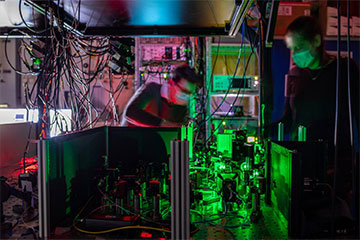
Researchers in the QuTech collaboration in the Netherlands have shown how to teleport information using three nodes and two quantum memories. The information is received inside the black aluminum cylinder, which contains an artificial diamond cooled to -270 °C in order to minimize environmental noise and enable quantum control. [Image: M. de Lorijn for QuTech]
Researchers in the Netherlands have shown how to teleport information between two nodes in a quantum network that are not directly connected to one another (Nature, doi: 10.1038/s41586-022-04697-y). They say that the research, which relied on improvements to quantum memory and the monitoring of entanglement, represents a building block for a future quantum internet.
The quest for teleportation
Teleportation involves transferring a quantum state from one particle to another without any physical transmission of information between the two—apart from a classical message containing purely technical data. Implemented between multiple users over long distances, the technique could ultimately enable hacker-proof communication, distributed quantum computing and exceptionally powerful sensing.
Since first showing how to teleport quantum bits in the form of photons 25 years ago, and extending such demonstrations via satellite links and city-wide fiber networks, scientists have more recently achieved teleportation between qubits made from trapped ions, atomic ensembles and other types of matter—which can serve as stationary nodes of a network. However, until now, a series of technical obstacles has meant that these matter-based implementations have only been possible using qubits directly linked to one another.
Swapping entanglements
Teleportation can, in principle, enable information to be transferred with complete accuracy over unlimited distances. But its implementation relies on entanglement. This counter-intuitive and purely quantum phenomenon involves a connection between two distant objects such that any change to the state of one will instantaneously alter the state of the other.
Quantum networks would ideally provide entanglement-on-demand, so that an entangled link could be established between any two users no matter how far apart they are. But over distances of more than a few tens of kilometers, loss in the optical fiber used to transmit the photons leads to very low entangling rates. Unlike classical telecommunications, the no-cloning theorem prevents faithful amplification of weak quantum signals.
The solution lies in what is known as entanglement swapping, in which two remote users create separate entangled links with a central node. A Bell-state measurement at that node breaks the original links and instead creates a single entangled connection between the remote parties—a process that can, in principle, be repeated multiple times to extend the distance indefinitely. However, the probabilistic nature of entanglement means there is no guarantee that the individual links can be established simultaneously. This calls for a quantum memory to store entangled qubits as well as “heralding” photons to signal the successful formation of links.
Teleportation between Alice and Charlie

Researchers work on one of the quantum-network nodes, where mirrors and filters guide the laser beams to the diamond chip. [Image: M. de Lorijn for QuTech]
In the latest work, Ronald Hanson and colleagues at the Delft University of Technology in the Netherlands have demonstrated how to overcome a series of problems that can reduce the fidelity of entanglement swapping—showing how to detect and thereby reject false heralding events as well as how to deal with slight variations in photon frequency (which means the particles become distinguishable from one another). They also have tackled two other problems encountered by teleporters, demonstrating improvements to both a quantum memory’s coherence time and readout fidelity.
With those improvements in hand, Hanson and colleagues showed how to teleport information across a three-node network. Strung out along a straight line, the three nodes were known (in keeping with cryptographic convention) as Alice, Bob and Charlie. Each of the nodes had a qubit encoded using the electron spin of a defect within an artificial diamond crystal, while Bob and Charlie also had memory qubits made from carbon-13 atoms within the diamond.
To set up their teleporter, the researchers first entangled Alice’s qubit with Bob’s and then stored Bob’s half of the entangled state in the carbon-13 memory. In the meantime, they established entanglement between Bob’s electron spin and Charlie’s qubit before carrying out a Bell-state measurement at Bob to link the two remote users wanting to teleport—Alice and Charlie.
To actually do the teleportation, Charlie switched his half of the entangled state to his carbon memory and then put his electron spin into the state that he wanted to teleport. At this point, he too carried out a Bell-state measurement, using his two qubits as input. The automatic effect of this was to change Alice’s qubit, such that by carrying out a certain measurement on that qubit, she could recover the state that Charlie had encoded. In this way, Charlie was able to transfer his information to Alice without any physical transmission apart from the classical communication of his Bell-state measurement result (which tells Alice which measurement she then needs to perform).
Aiming for large-scale network
By teleporting six different quantum states and comparing Alice’s result with Charlie’s input, Hanson and colleagues found they were able to teleport with an average fidelity of about 0.7 (fidelity measures the degree of overlap between the quantum information received and that sent). This was three standard deviations above the upper classical bound of 2/3, and therefore proof of the protocol’s quantum nature. What’s more, they showed they could remain above the classical bound even when carrying out so-called unconditional teleportation—which means that teleportation is carried out successfully each time Alice and Charlie share an entangled state.
The researchers are now working to overcome a number of major hurdles they face in realizing a large-scale quantum network. For one thing, they are looking to convert their currently lab-based network so that it works outdoors over long distance via pre-existing fiber. They also aim to make their hardware faster and operate with a higher fidelity. In addition, they are working with computer scientists on a quantum-network control stack to make the network programmable.
